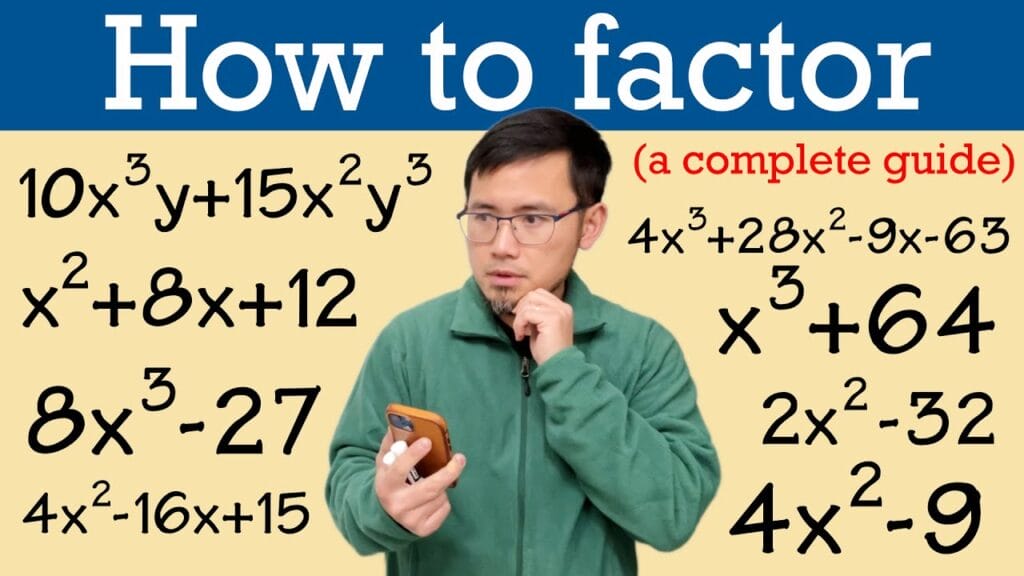Factoring is one of the most important skills in algebra and higher-level mathematics. It is the process of rewriting an expression or equation in terms of its factors, which are simpler expressions that multiply together to give the original polynomial. Factoring a polynomial makes it easier to solve equations, simplify expressions, and understand the structure of mathematical relationships.
In this guide, we will cover what polynomials are, why factoring is useful, and the different methods you can use to factor polynomials step by step. Whether you are a student learning algebra for the first time or someone brushing up on math skills, this guide will help you gain confidence in factoring.
What is a Polynomial?
A polynomial is an algebraic expression made up of variables, constants, and exponents combined using addition, subtraction, and multiplication. Examples include:
- x2+5x+6x^2 + 5x + 6×2+5x+6
- 3y3−2y2+y−43y^3 – 2y^2 + y – 43y3−2y2+y−4
- 2a4−6a22a^4 – 6a^22a4−6a2
The word “polynomial” comes from “poly” meaning many and “nomial” meaning terms. Each part of a polynomial separated by plus or minus signs is called a term.
Why Factor a Polynomial?
Factoring serves several purposes in mathematics:
- Solving equations – If a polynomial is factored, you can apply the zero-product property to solve equations.
- Example: x2+5x+6=0 ⟹ (x+2)(x+3)=0 ⟹ x=−2,−3x^2 + 5x + 6 = 0 \implies (x+2)(x+3) = 0 \implies x = -2, -3×2+5x+6=0⟹(x+2)(x+3)=0⟹x=−2,−3.
- Simplifying expressions – Factored forms make simplification easier, especially in rational expressions.
- Understanding structure – Factoring reveals hidden patterns in polynomials.
- Applications – In physics, engineering, and economics, factored polynomials model real-world problems.

Basic Factoring Techniques
1. Factoring Out the Greatest Common Factor (GCF)
The GCF is the largest factor shared by all terms of the polynomial. Always start factoring by pulling out the GCF.
Example:
Factor 6×3+9x26x^3 + 9x^26×3+9×2.
- GCF of 6x36x^36×3 and 9x29x^29×2 is 3x23x^23×2.
- Factored form: 3×2(2x+3)3x^2(2x + 3)3×2(2x+3).
2. Factoring Trinomials
A trinomial has three terms, usually in the form: ax2+bx+cax^2 + bx + cax2+bx+c
There are two common cases:
Case 1: When a=1a = 1a=1
Look for two numbers that multiply to ccc and add to bbb.
Example:
Factor x2+7x+12x^2 + 7x + 12×2+7x+12.
- Numbers: 333 and 444 (3×4=123 \times 4 = 123×4=12, 3+4=73 + 4 = 73+4=7).
- Answer: (x+3)(x+4)(x+3)(x+4)(x+3)(x+4).
Case 2: When a≠1a \neq 1a=1
Multiply aaa and ccc, then find numbers that add to bbb.
Example:
Factor 2×2+5x+32x^2 + 5x + 32×2+5x+3.
- Multiply a×c=2×3=6a \times c = 2 \times 3 = 6a×c=2×3=6.
- Numbers: 222 and 333 (2+3=52+3=52+3=5).
- Rewrite: 2×2+2x+3x+32x^2 + 2x + 3x + 32×2+2x+3x+3.
- Group: (2×2+2x)+(3x+3)(2x^2+2x) + (3x+3)(2×2+2x)+(3x+3).
- Factor: 2x(x+1)+3(x+1)2x(x+1) + 3(x+1)2x(x+1)+3(x+1).
- Answer: (2x+3)(x+1)(2x+3)(x+1)(2x+3)(x+1).

3. Factoring by Grouping
Grouping is useful when a polynomial has four or more terms. You split the terms into groups and factor out common elements.
Example:
Factor x3+3×2+2x+6x^3 + 3x^2 + 2x + 6×3+3×2+2x+6.
- Group: (x3+3×2)+(2x+6)(x^3 + 3x^2) + (2x + 6)(x3+3×2)+(2x+6).
- Factor: x2(x+3)+2(x+3)x^2(x+3) + 2(x+3)x2(x+3)+2(x+3).
- Final: (x2+2)(x+3)(x^2+2)(x+3)(x2+2)(x+3).
4. Difference of Squares
This pattern occurs when you have two perfect squares separated by subtraction: a2−b2=(a−b)(a+b)a^2 – b^2 = (a – b)(a + b)a2−b2=(a−b)(a+b)
Example:
Factor x2−16x^2 – 16×2−16.
- Recognize: x2−42x^2 – 4^2×2−42.
- Answer: (x−4)(x+4)(x-4)(x+4)(x−4)(x+4).
5. Perfect Square Trinomials
A trinomial is a perfect square if it can be written as: a2+2ab+b2=(a+b)2a^2 + 2ab + b^2 = (a+b)^2a2+2ab+b2=(a+b)2 a2−2ab+b2=(a−b)2a^2 – 2ab + b^2 = (a-b)^2a2−2ab+b2=(a−b)2
Example:
Factor x2+6x+9x^2 + 6x + 9×2+6x+9.
- Recognize: x2+2(3)(x)+32x^2 + 2(3)(x) + 3^2×2+2(3)(x)+32.
- Answer: (x+3)2(x+3)^2(x+3)2.

6. Sum or Difference of Cubes
Cubic polynomials also have special patterns:
- Sum of cubes: a3+b3=(a+b)(a2−ab+b2)a^3 + b^3 = (a+b)(a^2 – ab + b^2)a3+b3=(a+b)(a2−ab+b2)
- Difference of cubes: a3−b3=(a−b)(a2+ab+b2)a^3 – b^3 = (a-b)(a^2 + ab + b^2)a3−b3=(a−b)(a2+ab+b2)
Example (difference):
Factor x3−8x^3 – 8×3−8.
- Recognize: x3−23x^3 – 2^3×3−23.
- Answer: (x−2)(x2+2x+4)(x-2)(x^2+2x+4)(x−2)(x2+2x+4).
7. Factoring Higher-Degree Polynomials
For polynomials of degree 3 or higher, you often use:
- Synthetic division
- Long division
- Rational root theorem
These methods help break down polynomials into quadratic or linear factors.
Example:
Factor x3−4×2−7x+10x^3 – 4x^2 – 7x + 10×3−4×2−7x+10.
- Possible rational roots: ±1, ±2, ±5, ±10.
- Test x=1x=1x=1: 1−4−7+10=01 – 4 – 7 + 10 = 01−4−7+10=0. So, (x−1)(x-1)(x−1) is a factor.
- Divide x3−4×2−7x+10x^3 – 4x^2 – 7x + 10×3−4×2−7x+10 by (x−1)(x-1)(x−1): result is x2−3x−10x^2 – 3x – 10×2−3x−10.
- Factor further: (x−5)(x+2)(x-5)(x+2)(x−5)(x+2).
- Final answer: (x−1)(x−5)(x+2)(x-1)(x-5)(x+2)(x−1)(x−5)(x+2).
Step-by-Step Strategy for Factoring Any Polynomial
- Check for GCF – Always start by factoring out the greatest common factor.
- Look for special patterns – Difference of squares, perfect square trinomials, sum/difference of cubes.
- Count the terms –
- 2 terms: likely difference of squares or cubes.
- 3 terms: try trinomial factoring.
- 4 terms: try grouping.
- Use synthetic or long division – For higher-degree polynomials.
- Verify your factors – Multiply them back to confirm.
Common Mistakes to Avoid
- Forgetting to factor out the GCF first.
- Mixing up signs when finding factors.
- Stopping too early and not fully factoring.
- Confusing difference of squares with sum of squares (remember, a2+b2a^2+b^2a2+b2 does not factor over real numbers).
Practice Problems
- Factor 12×3−6x212x^3 – 6x^212×3−6×2.
- Factor x2−9x+20x^2 – 9x + 20×2−9x+20.
- Factor y3+27y^3 + 27y3+27.
- Factor 2×3+6×2+4x2x^3 + 6x^2 + 4x2x3+6×2+4x.
- Factor x4−16x^4 – 16×4−16.
Answers:
- 6×2(2x−1)6x^2(2x-1)6×2(2x−1)
- (x−4)(x−5)(x-4)(x-5)(x−4)(x−5)
- (y+3)(y2−3y+9)(y+3)(y^2 – 3y + 9)(y+3)(y2−3y+9)
- 2x(x2+3x+2)=2x(x+1)(x+2)2x(x^2+3x+2) = 2x(x+1)(x+2)2x(x2+3x+2)=2x(x+1)(x+2)
- (x2−4)(x2+4)=(x−2)(x+2)(x2+4)(x^2-4)(x^2+4) = (x-2)(x+2)(x^2+4)(x2−4)(x2+4)=(x−2)(x+2)(x2+4)
Applications of Factoring Polynomials
- Quadratic equations – Factoring is the quickest method to solve many quadratic equations.
- Graphing functions – Roots found by factoring tell us where a graph crosses the x-axis.
- Simplifying fractions – Rational expressions simplify easily when numerator and denominator are factored.
- Real-life modeling – Factoring helps solve motion, area, and optimization problems.
Final Thoughts
Factoring polynomials is a foundational skill in algebra that unlocks deeper understanding of equations, functions, and real-world problem-solving. By mastering the methods—GCF, trinomial factoring, grouping, difference of squares, and cubes—you can handle any polynomial with confidence.
Remember: always start simple, look for patterns, and practice regularly. With time, factoring becomes second nature and will serve as a powerful tool in your mathematical journey.


